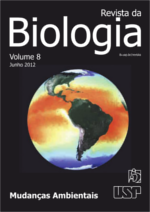Climatic changes and fossoriality: implications for the subterranean herpetofauna
DOI:
https://doi.org/10.7594/revbio.08.04Keywords:
Climatic changes, subterranean environment, thermal sensibility, fossorial habit, herpetofaunaAbstract
Several studies have discussed the possible influence of global warming on biological traits, but most of the predictions ignore likely effects of spatial and temporal heterogeneity associated with different scales of temperature change, assuming therefore that this impact would be homogeneous in a given environment. However, the same habitat may have a peculiar dynamics of temperature fluctuation;for example, subterranean micro-habitats exhibit daily and seasonal temperature fluctuations very peculiar, although most speculations focus on the herpetofauna that inhabits the surface. The generalizations about the forecasts of climatic changes and global warming should therefore be cautious and also incorporate particularities of the species and their respective thermal relationships with microenvironmental conditions.Downloads
Download data is not yet available.
Downloads
Published
2018-04-23
Issue
Section
Revisão
License
We ensure that our journal does not retain any copyright and that these are exclusive of the author(s) of the text. In that sense, we intend to break any restrictions to the published material and to achieve more intensely our goal of communicating science.
How to Cite
Closel, M. B., & Kohlsdorf, T. (2018). Climatic changes and fossoriality: implications for the subterranean herpetofauna. Revista Da Biologia, 8(1), 19-24. https://doi.org/10.7594/revbio.08.04






